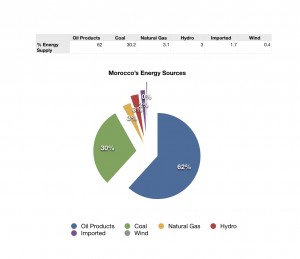To follow up on Nicky’s post about solar energy efficiency, Morocco has recently launched a power plant (called the Noor I) in the Sahara Desert that is capable of generating 160 megawatts of power. These solar panels cover thousands of acres of the desert (can actually be seen from space) and when the two other Noor plants are implemented they will offer renewable energy to over a million Moroccans. What are the economic impacts of this implementation?
Right now, Morocco relies on imported sources of energy for 97% of its total energy use (according to the World Bank) while also having its electricity demand increasing at nearly 8% per year from their economic growth. By 2018, the solar plant is expected to reduce Morocco’s reliance on oil by two and a half million tons. Here’s a neat pie chart of the percentage of Morocco’s each energy source:
Not only will they be reducing their carbon footprint, they will be able to export some of their energy they have left over to other countries. This could help them see growth in their economy overall. There is a $9 billion cost to Morocco for the total project, but that will be worth it for the lasting environmental and economic impacts.
Also, the plant is incredibly efficient due to the fact that it stores energy even after the sun goes down and won’t be inhibited from clouds. The first part of the power plant will produce three hours of electricity per day, and the entire complex in the end will produce 20 hours per day for the Moroccan citizens. This project is a tremendous step forward for renewable energy, especially in place that relies on fossil fuels so much like Morocco. They could be setting a strong example for other countries that are in similar weather systems, and could be taking advantage of the sun with solar thermal power plants.

Where did you get the numbers for the graph on Morocco’s Energy Sources?
For the picture?